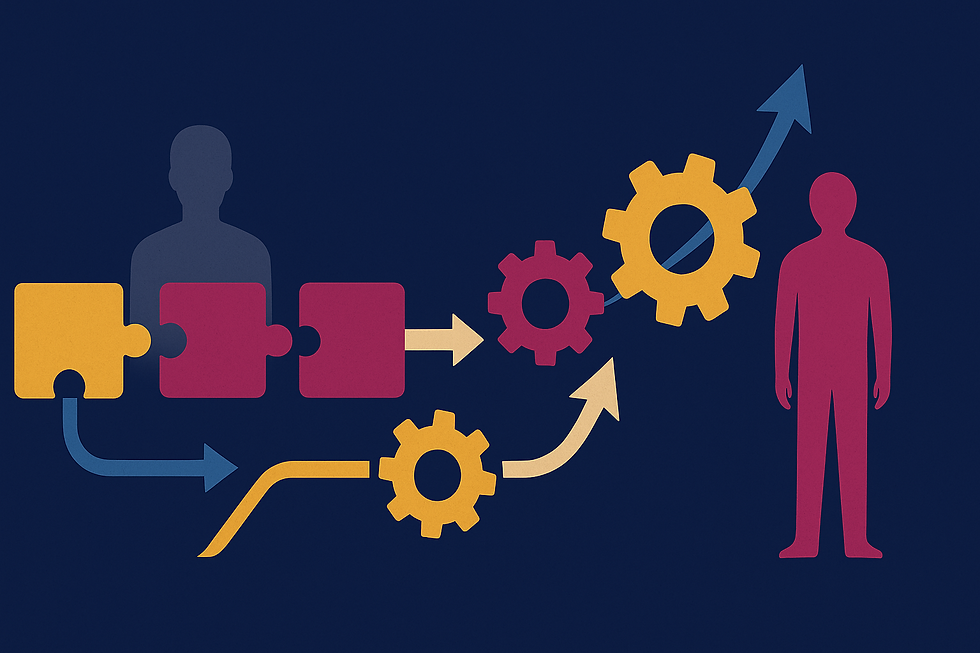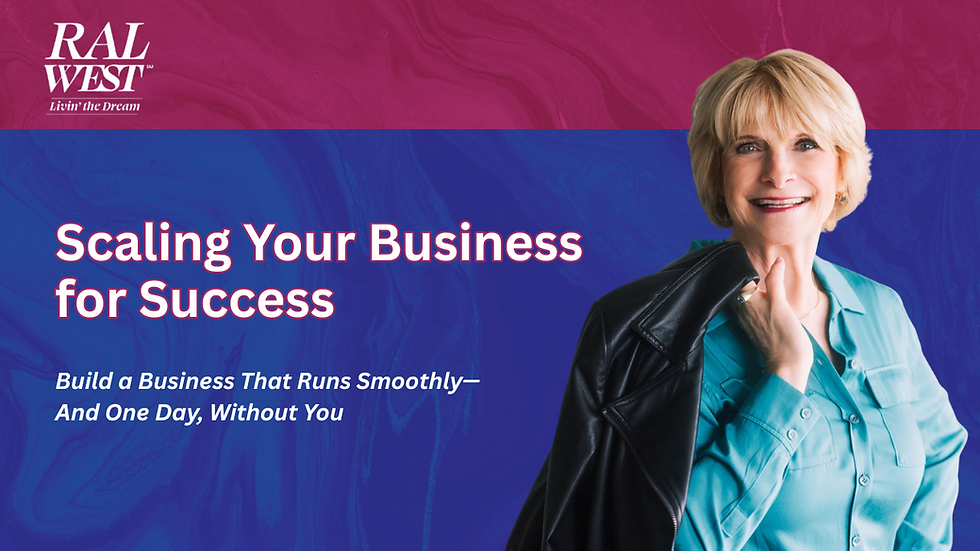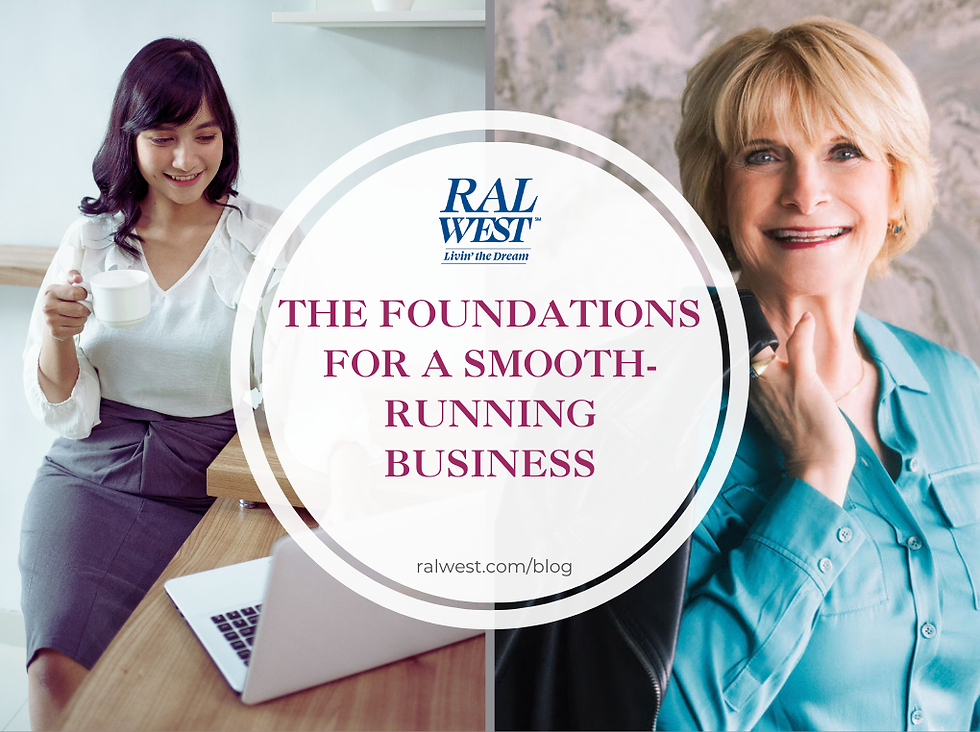Scaling Your Business for Success
- bryan6708
- Sep 12
- 5 min read
Build a Business That Runs Smoothly—And One Day, Without You
Introduction: Want a Business You Can Sell Someday? Start by Replacing Yourself
There’s a common goal among most entrepreneurs—even if they don't say it out loud:
They want freedom.
That could mean freedom to sell the business.
Or pass it on to someone else.
Or step away without it falling apart.
Or just to take a real vacation without worrying about the inbox.
But that freedom doesn’t come from working harder.
It comes from scaling smarter—and that starts by making your business less dependent on you.
I learned this firsthand when we sold one of our companies to Alaska Airlines.
It wasn’t just a great product or a recognizable brand that made the deal possible.
It was that we had built something that could run without us.
We weren’t the glue holding it together.
We had created systems, trained a team, and built processes that delivered results—even when we weren’t in the building.
And that’s what made the business valuable.
If you're the only one who can run your business, you're not just limiting its growth—you're also limiting its value.
Part 1: Scaling Isn’t About Doing More—It’s About Letting Go

Let’s start with a truth that might sting a little:
That job may come with more flexibility than a traditional 9–5, but it also comes with more pressure, more responsibility, and more stress—especially if you don’t have a team or systems in place.
So what does scaling actually mean?
It’s not just about growing revenue.
It’s about:
Creating consistency
Delegating delivery
Building internal capacity
Removing single points of failure (especially if that’s you)
📌 The goal isn’t just to make more—it’s to make more while doing less.
Part 2: Systemize Before You Scale

If your internal operations are messy, scaling will only make the mess bigger.
That’s why the first step is always to document and standardize your core processes.
🧩 Where to Start:
Client onboarding
Service delivery
Billing and collections
Team communication
Marketing campaigns
Sales calls and proposals
Don’t overcomplicate it.
Start with a checklist or a Google Doc that walks through each step.
Use Loom to record your screen as you do the task.
Upload it to a shared folder your team can access.
📌 One documented process = hours of future training saved, and one more step toward freedom.
Part 3: Build a Team That Can Deliver Without You

This is the heart of scalable success.
When your team knows how to execute without you approving every task or solving every issue, your business becomes something that’s truly sellable, transferable, or simply sustainable.
✅ How to Make That Happen:
1. Hire for Function, Not Just Help
Don’t just hire a generalist to "take things off your plate."
Define roles based on function: operations, client support, finance, marketing.
2. Train With Clarity
Use the systems you documented. Set clear expectations. Show them the “why” behind each task—not just the “how.”
3. Empower Ownership
Encourage team members to make decisions. Start small and increase their responsibility over time.
📌 One of the best signs of a scalable business is when your team brings you solutions—not just questions.
Part 4: Eliminate the Activities That Don’t Move the Needle

This is what separates owner-operators from owner-leaders.
When you’ve designed your business intentionally, you gain options.
You can:
Take time off
Focus on strategy
Enter new markets
Groom a successor
Sell your company
Or simply enjoy your life more
That’s not just good business design—it’s smart life design.
🧱 Key Elements of a Self-Sustaining Business:
Operations Manual: So others know how things work
Defined KPIs: So performance can be tracked without micromanagement
Accountable Team Members: So nothing falls through the cracks
Clear Communication Rhythm: So alignment happens without chaos
📌 Inside the Livin’ the Dream℠ Mastermind, this is a major milestone we help members achieve—stepping into the OWNER role instead of staying stuck as the OPERATOR.
Part 5: Remove Yourself from the Critical Path

The critical path is the sequence of tasks that must be completed for your business to function.
If YOU are in the middle of every single one, you’re the bottleneck.
Ask yourself:
Would my business run tomorrow if I took a week off?
Who would handle client issues?
Who would deliver the product or service?
Who would follow up on leads?
If the answer is “no one,” you’re still involved in the critical path.
📌 The goal isn’t to disappear—it’s to make sure you’re not a roadblock.
Part 6: Understand What Makes a Business Valuable

Even if you never plan to sell, running a business that could be sold forces you to build it right.
Buyers look for:
Operational systems
Minimal founder involvement
Strong team infrastructure
Clear financials
Documented workflows
Even if you’re not selling, those are the same ingredients that give you:
✅ Time freedom
✅ Mental clarity
✅ Scalability
✅ Resilience
So whether you plan to exit or expand, the strategy is the same:
Build something that runs without you.
Part 7: Create Reporting and Visibility That Doesn’t Rely on You

Scaling successfully means knowing what’s going on—without being in every conversation.
You need:
A place to track performance (KPIs)
A simple reporting rhythm (weekly, monthly)
A team that can surface issues and own solutions
Simple tools that support this:
📌 You don’t need enterprise software. You just need visibility and accountability.
Part 8: Decide What Scaling Looks Like for You

Here’s something I always ask my clients and Mastermind members:
“What does successfully scaled look like for you?”
It’s different for everyone.
For some, it’s a team of 10 and consistent six-figure months.
For others, it’s working 15 hours a week while traveling.
For others still, it’s preparing for a legacy exit or acquisition.
There’s no one-size-fits-all.
But the key is that your business supports your life—not the other way around.
Conclusion: Start Today—Scale Intentionally
You don’t need to overhaul everything at once.
But if you want a business that grows—without grinding you down—you do need to start making it less dependent on you.
Here’s where to begin:
✅ Document one key process
✅ Delegate one recurring task
✅ Create a checklist or template your team can use
✅ Review your weekly workload—what shouldn’t be on your plate?
✅ Schedule a conversation with your team about ownership and next steps
Reflection Prompt:
What’s one step you’ve taken to make your business less dependent on you?
Hit reply and let me know—I’d love to hear it.
🎧 Podcast Spotlight: Gina Gardiner & Friends Radio Show
I recently had the pleasure of joining Gina Gardiner on her Gina Gardiner & Friends Radio Show. We talked about Business Leader & Systemization Expert Insights—what it really takes to lead with clarity, build the right systems, and design a business that gives you both freedom and growth.
🎙️ Listen here: Business Leader & Systemization Expert Insights
P.S. Want help building systems that support real growth—without adding stress?
Watch my free training video here: https://www.ralwest.com/six-principles
Or check out my Mastermind, designed to teach entrepreneurs like you to build scalable systems and make confident decisions https://www.ralwest.com/mastermind
Subscribe to my YouTube channel for insights on business systems, leadership, and entrepreneurial freedom: https://www.youtube.com/@RalWest
What was your biggest takeaway from this week's newsletter?





Comments